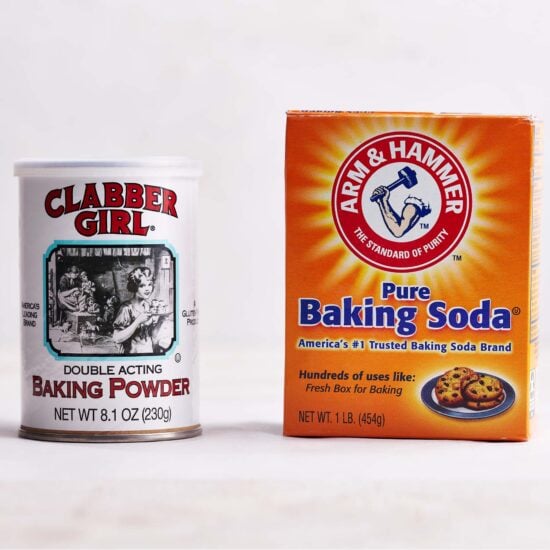
Baking Soda vs. Baking Powder
This post may contain affiliate links. Read our disclosure policy.
Chemical leavening agents like baking soda and baking powder can have a profound effect on your favorite baked goods – but what is baking soda vs. baking powder? How do they actually work? What are the differences between them?
Those are the questions I’ll be answering for you today, and guess what… I brought VISUALS! Let’s dive in!
Baking Soda vs. Baking Powder
What Are Chemical Leaveners? Can You Substitute Baking Powder For Baking Soda And Vice Versa?
Baking Powder and Baking Soda are both chemical leaveners that work to create light textures in baked goods. They release gases, primarily carbon dioxide, through chemical reactions between acids and bases – but both only work under the correct conditions. Although baking powder actually contains baking soda, the two leaveners are very different and cannot be simply swapped in recipes.
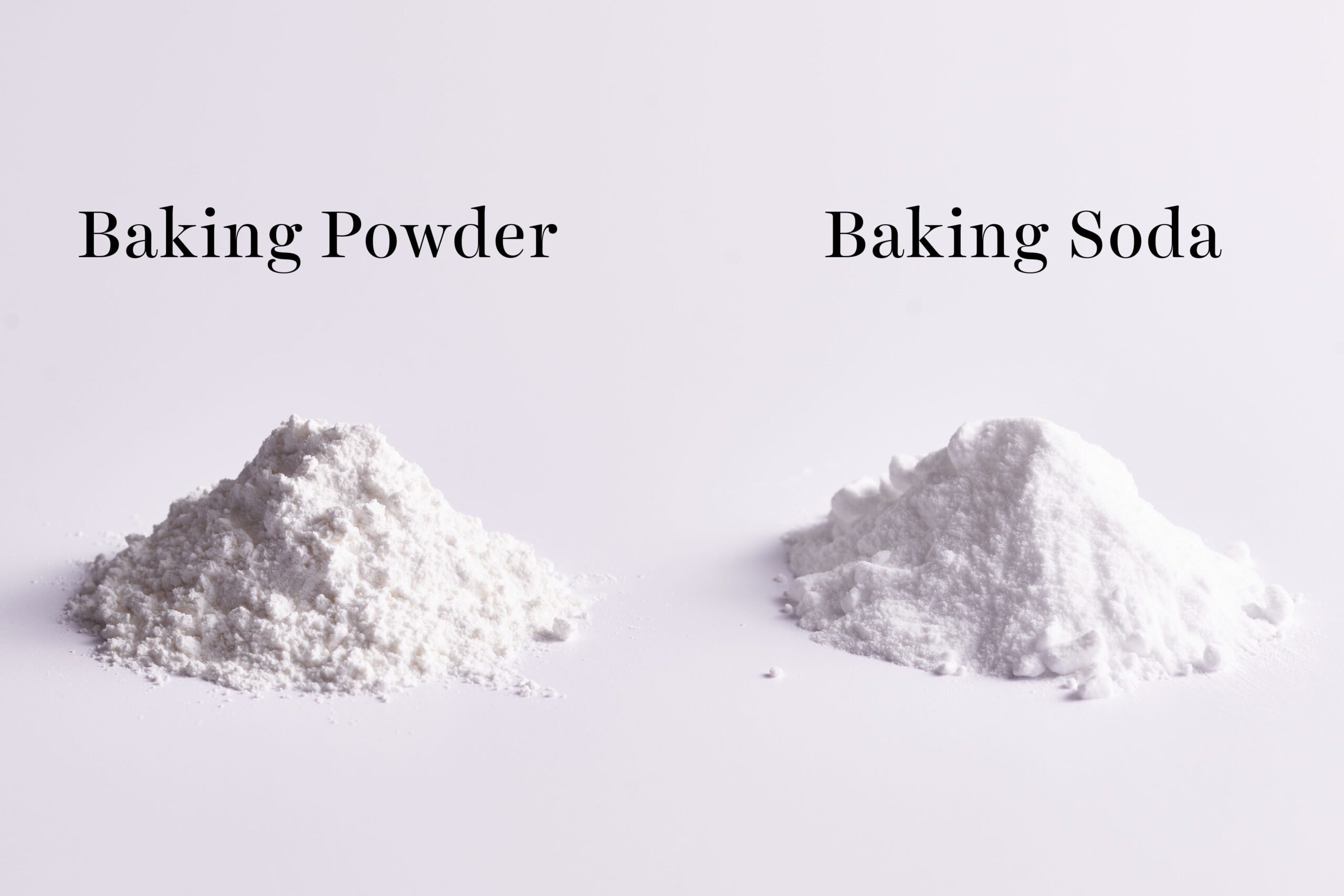
Baking Powder And Baking Soda Both Provide Three Similar Main Functions
- Leavening: Baking powder and soda release gases that form bubbles, which expand within the batter or dough during the baking process. The protein in the batter or dough then sets around those air pockets. This creates rise and lift in the structure of your baked goods.
- Tenderizing: As the gases form and expand, cell walls in baked goods begin to stretch and thin. This results in a more tender texture that’s easier to eat.
- Provide flavor: Small amounts of chemical leaveners can contribute a salty, sour flavor that is distinct to baked goods like biscuits, scones, or Irish soda bread.
Why It’s SO Important to Use a Leavener in Most Recipes
Take a look at the image below to see what happens when NO chemical leavener is used in my Ultimate Muffin Recipe, compared to using both baking powder and baking soda. The muffins without any leavener are extremely dense and almost taste unbaked, despite being baked for the exact same amount of time as the other!
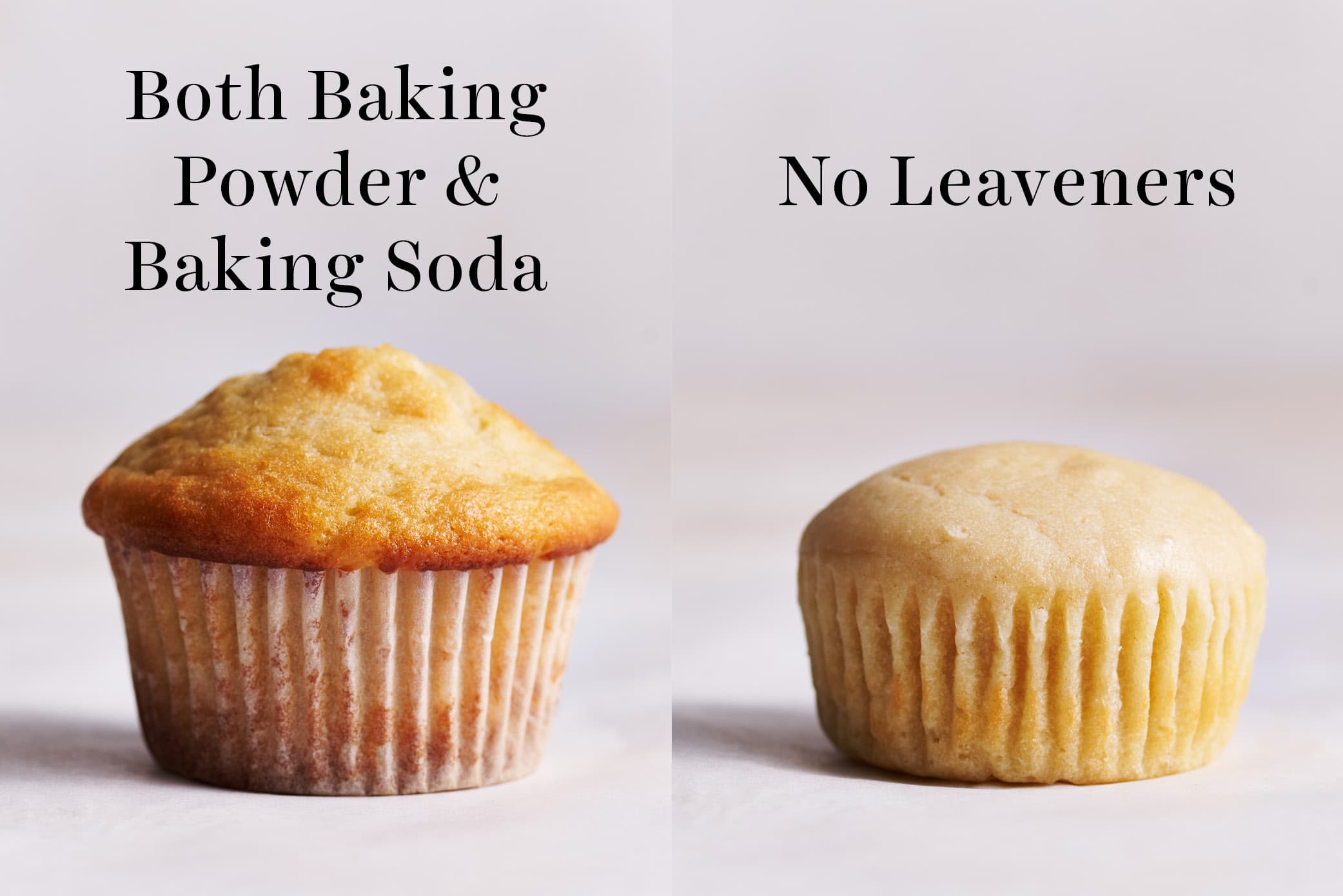
What is Baking Soda and How Does It Work?
Baking soda, also known as bicarbonate of soda and referred to scientifically as sodium bicarbonate, is a natural pure alkaline substance, activated by moisture and acid present in the batter or dough, to produce gas. There must be some acidic ingredient in the recipe for baking soda to function. Naturally acidic ingredients that will activate baking soda include:
- Buttermilk
- Sour cream
- Yogurt
- Lemon juice
- Honey
- Natural aka unsweetened cocoa powder (NOT Dutch-processed)
- Unsweetened chocolate
- Brown sugar
- Molasses
- Fruits & fruit juices
Baking soda begins to leaven as soon as it touches the liquid present in the dough or batter. This means that if you wait too long before baking, you may notice a decrease in leavening effect (especially in wetter dough or batters).
In professional baking, this is referred to as ‘bench tolerance,’ or how long a batter or dough can be stored before it has lost its leavening. For recipes that rely mostly on baking soda for their structure which are also full of moisture, such as certain cake batters, they shouldn’t be stored too long before baking.
If you use too much baking soda, you may taste an unpleasant metallic, soapy, or bitter flavor in your food. This can happen by accident by mismeasuring or when making other changes to an established recipe.
How Baking Soda Changes Baked Goods
- Baking soda elevates pH.
- Baking soda helps add a beautiful browned color to baked goods by elevating pH levels.
- A higher pH in baked goods can affect color, flavor, texture, and gluten development! For example, baking soda in brownies or gingerbread enhances the deep dark color and smoothes out the chocolate flavor.
- Baking soda is also present in baking powder, but in a smaller amount, so it has a lower pH level which results in less browning.
- Baking soda in cookies leads to more spread and a crispy edge compared to baking powder, as shown in the photos below.
How to Test Baking Soda for Freshness
Since baking soda must be fresh to work properly, it’s important to switch out your container before the expiration date. However, baking soda can lose its effectiveness even before that date. Here’s how to ensure your baking soda is still effective:
- Place 1/4 teaspoon baking soda in a bowl and pour 1 teaspoon of distilled vinegar on top.
- If the baking soda immediately bubbles violently, it is fresh.
- If nothing happens, throw away the baking soda and buy a new package.
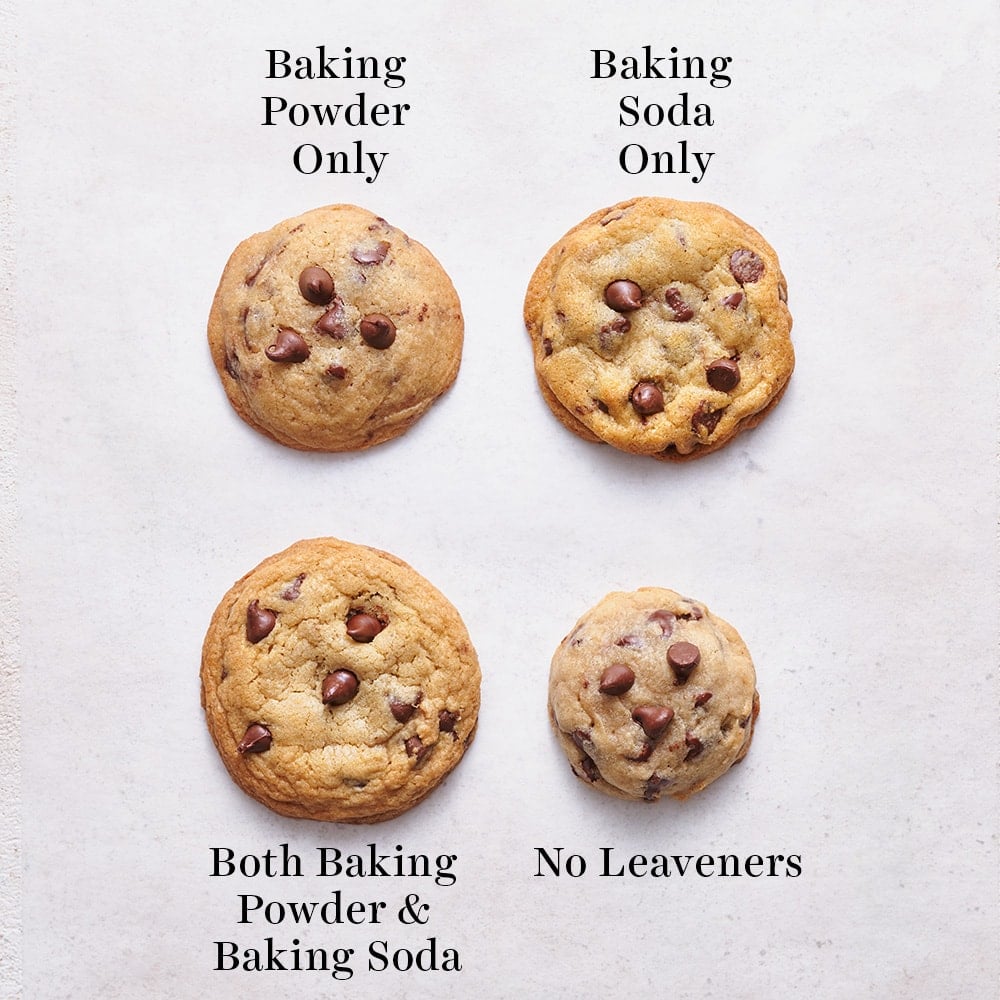
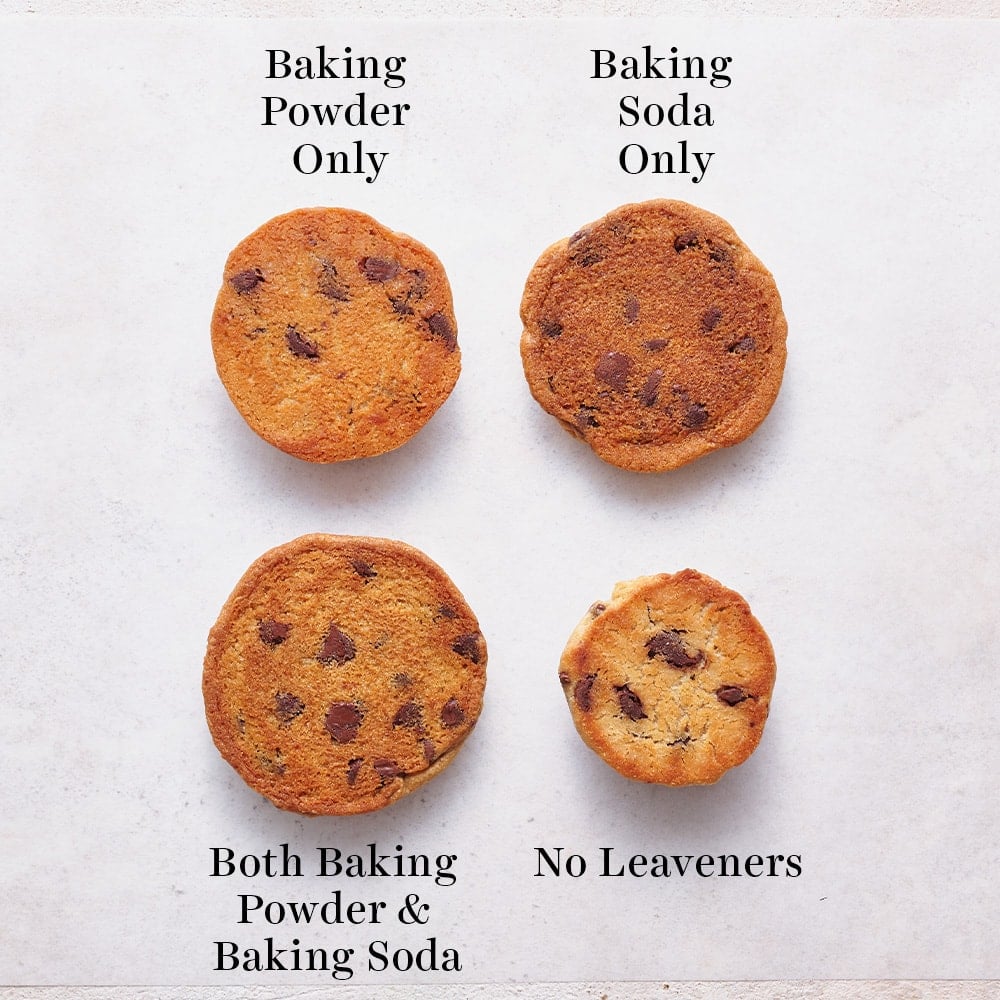
What is Baking Powder and How Does it Work?
Baking powder is a combination of:
- Baking soda
- An acid (usually cream of tartar)
- An anti-caking agent (such as cornstarch)
Because it contains both the acid and the base necessary for the desired chemical reaction, your batter or dough doesn’t require additional acidic ingredients to work properly. All baking powder needs to be activated is moisture and heat! This makes baking powder a complete leavening system.
Most products available in the U.S. today are double-acting baking powders, meaning it reacts twice. Its first reaction occurs when combined with liquid to help aerate the batter or dough, and a second more slow-acting reaction occurs when heated in the oven. This means that baking powder-leavened doughs and batters have a better bench tolerance and can be stored and baked at a later time. If using aluminum-free baking powder, I recommend looking for one that is also marked as double acting, for best results.
How Baking Powder Changes Baked Goods
- The small amount of cream of tartar in baking powder decreases pH and weakens gluten.
- In recipes like muffins, biscuits, and cakes, many of which rely entirely on baking powder, this results in a tighter, whiter, and delicate texture.
How to Test Baking Powder for Freshness
Baking powder can lose its effectiveness before the expiration date. Here’s how to check it’s still active:
- Place 1 teaspoon of baking powder in a small bowl with 1 cup of hot water from the tap.
- If it bubbles up, the baking powder is fresh.
- If nothing happens, throw the baking powder away and buy a new container.
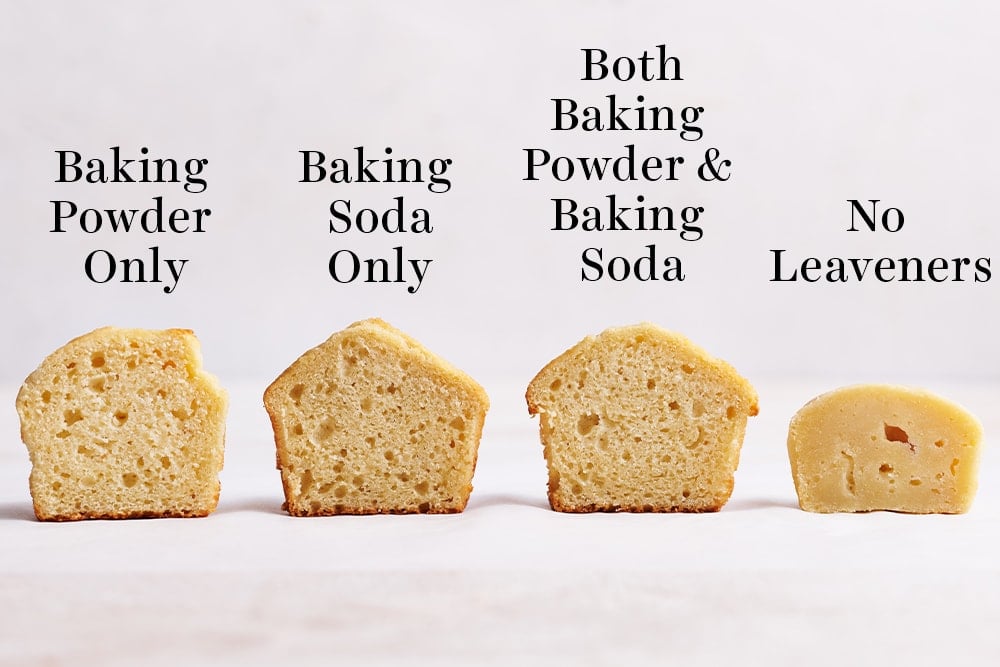
Why do Some Recipes Not Call for Baking Powder or Baking Soda?
The recipes where you don’t need a chemical leavener are usually:
- Recipes using yeast, which is an organic leavener that also works by producing gas bubbles (like bread)
- Baked goods that whip lots of air into the batter, or use whipped egg whites to leaven (like certain types of cake, such as a Angel Food Cake)
- Or are custard-based (like ice cream or crème brûlée), where rich creaminess is the desired texture.
Strength of Baking Powder vs. Baking Soda
It’s important to understand that baking soda is four times stronger than baking powder. This means 1 teaspoon of baking powder will raise a cup of flour, whereas only a 1/4 teaspoon of baking soda can produce the same effect. A general rule of thumb is that ½ teaspoon of baking soda is neutralized by 1 teaspoon of lemon juice or vinegar.
How to Store Baking Powder and Baking Soda
Purchase in the smallest size feasible based on how often you bake and use chemical leavening agents. Store in a cool place in an airtight container. Air and light can cause them to lose their effectiveness before their expiration date, which is why I included freshness tests above.
Which is Better: Baking Powder or Baking Soda?
Neither one is better than the other, they are simply used depending on the chemistry of the recipe, how it will be handled, and what the desired outcome is.
Take a look at some of the experiments Team Handle the Heat performed using baking powder and baking soda.
Below you’ll see the same exact base muffin recipe baked in the same trays at the same temperature for the same amount of time. The only difference is the chemical leavening agent used.
- Baking powder muffins: These were tall, light, slightly delicate, fluffy, and cakey. They were evenly domed on top. These were my favorite, followed by batch 3 which contained both.
- Baking soda muffins: These were slightly more browned, they had very tall peaks in the center, and they had an ever so slightly sour taste. Almost like there was sour cream in the batter (there wasn’t).
- Both baking soda and powder muffins: These muffins were the most browned and caramelized and had a more springy texture.
- No leavener muffins: These were leaden, dense, rubbery, and really just a doughy, inedible mess.
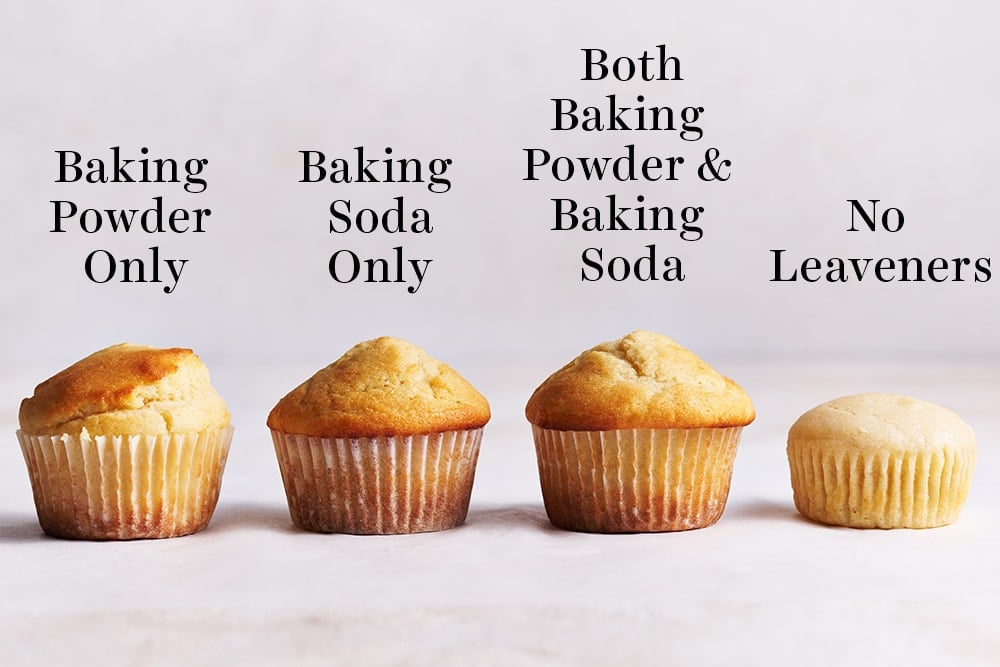
We repeated the same experiment with my Bakery Style Chocolate Chip Cookie Recipe.
- Baking powder cookies: These were extra thick and tall, not chewy, more fluffy, and not quite as flavorful.
- Baking soda cookies: These cookies were well browned with slightly crispy edges, chewy interiors, and regular thickness. They didn’t stale as quickly so they were more shelf stable. They were my favorite!
- No leavener cookies: These were dense, heavy, and had a similar texture to Mexican Wedding Cookies.
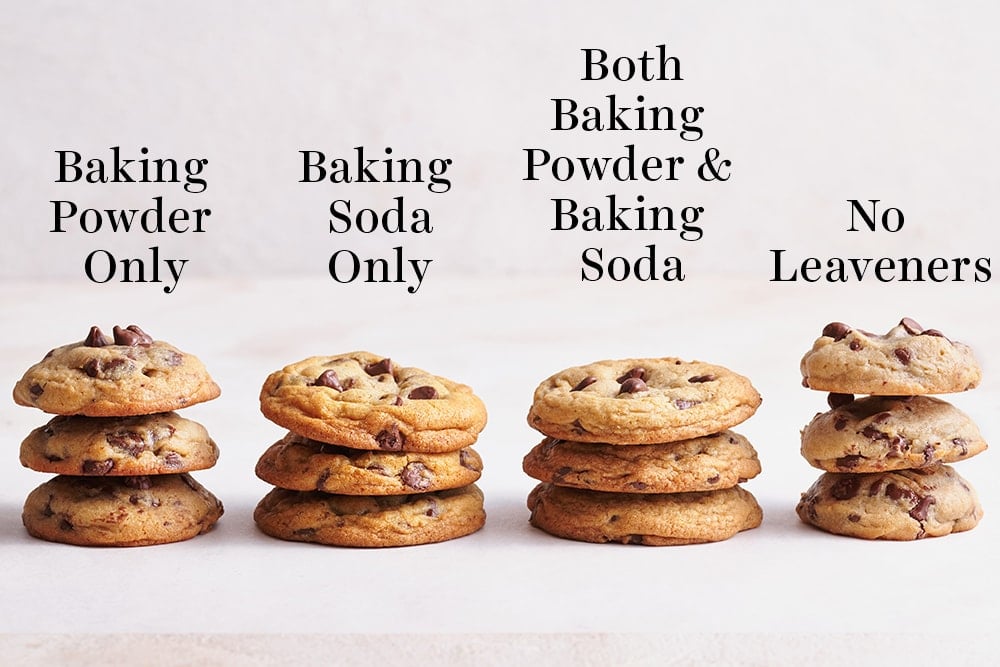
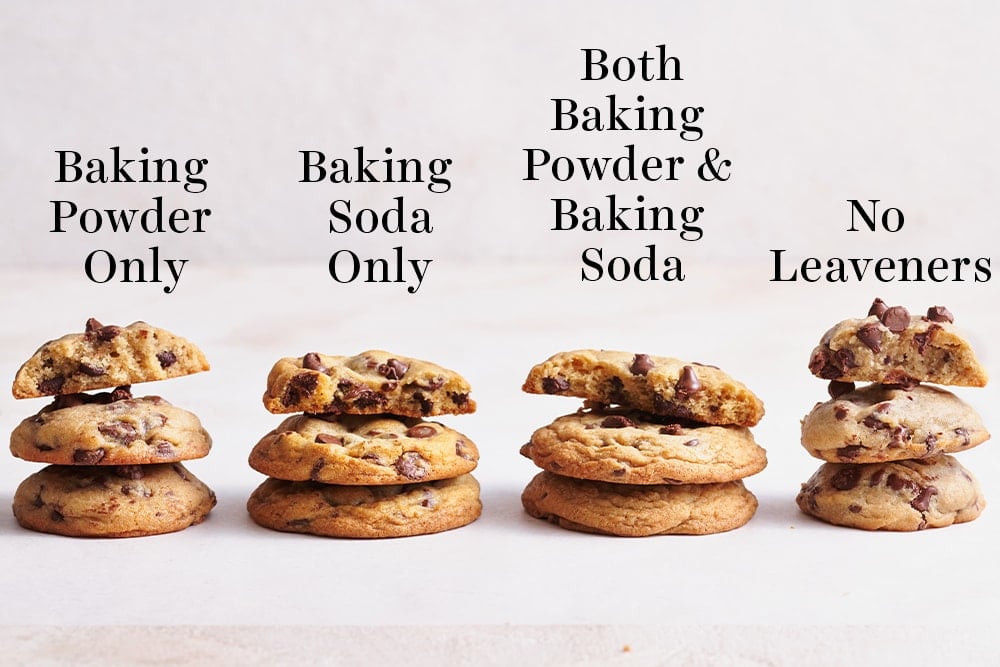
Why do Some Recipes Use Both Baking Soda and Baking Powder?
As you can see above, sometimes we want the best of both worlds! Some recipes call for both baking soda and baking powder in order to have the highest effect of acid-neutralizing and leavening powers.
This works especially well for an acidic dough that needs to be stored overnight, such as my favorite Ultimate Chewy Chocolate Chip Cookie recipe.
More Science of Baking Articles:
- Natural Cocoa vs. Dutch Process Cocoa Powder
- Active Dry Yeast vs. Instant Yeast
- How to Measure Flour
- Everything You Need to Know About Sugar in Baking
- Kosher Salt vs. Sea Salt vs. Table Salt
Recipes You’ll Love:
Photos by Joanie Simon | The Bite Shot.
About Tessa...
I share trusted baking recipes your friends will LOVE alongside insights into the science of sweets. I'm a professionally trained chef, cookbook author, and cookie queen. I love to write about all things sweet, carb-y, and homemade. I live in Phoenix, Arizona (hence the blog name!)
Leave a Comment & Rating
Add a Review or Question
© Handle the Heat - handletheheat.com
Join the Handle the Heat Community
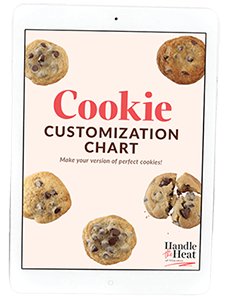
Instead of digging through cookbooks and magazines and searching the internet for amazing recipes, subscribe to Handle the Heat to receive new recipe posts delivered straight to your email inbox. You’ll get all the latest recipes, videos, kitchen tips and tricks AND my *free* Cookie Customization Guide (because I am the Cookie Queen)!

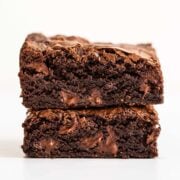

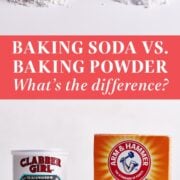
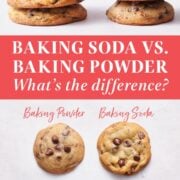
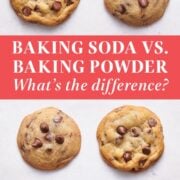
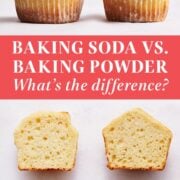
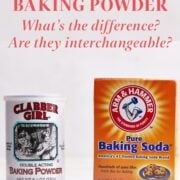
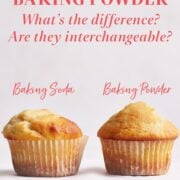
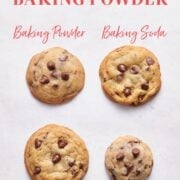
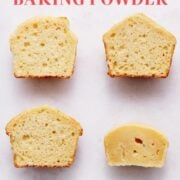
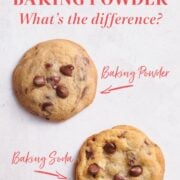



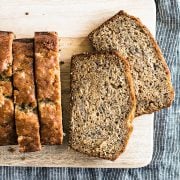
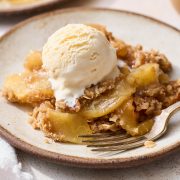
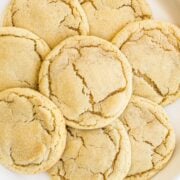
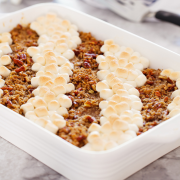

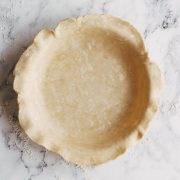
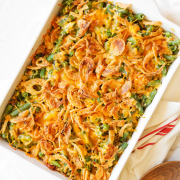
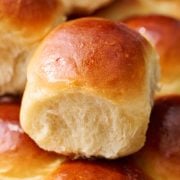
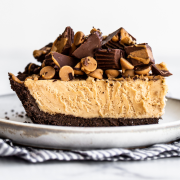

Thank you – to the point, answered the questions both scientifically and practically (I read several of your posts, and they were all the same, thank you again)
n\No annoying pop-ups or ‘please subscribe here’ panels hiding the content.
Kudos!!!!!
There are simply not enough posts like yours.
Thank you, thank you, thank you
Found your website early this year. Just love it. The question I have is about ovens. I’ve made several of the recipes, most recently the Cosmic Brownies, twice. Both times I believe I over cooked them using the CONVECTION BAKE setting on my Electric oven. I’m a firm believer that electric ovens, generally have a more even, constant temperature, and using the convection fan makes a difference in the cooking. Wondering if you might have thoughts about using, or not using convection. Possibly even suggest baking time with convection ovens. Appreciate any thoughts or comments. Blessings
Hi Keith! Glad to hear that you’re enjoying Tessa’s recipes and baking science articles! You seem to be right about electric ovens – across our whole Handle the Heat team, those with gas ovens struggle with maintaining temperature and need to bake most things a little longer than those with electric ovens. The convection setting on ovens can be a terrific asset, but they do tend to bake hotter and faster than the conventional setting. Some ovens will automatically adjust the temperature down, but others need to be manually adjusted. If your oven isn’t doing this for you, lower the temperature by about 25°F from what is stated in the recipe. If you don’t already have one, Tessa strongly recommends investing in an oven thermometer. They’re inexpensive and take the guesswork out of oven temps! Learn more about ovens and using an oven thermometer (as well as Tessa’s recommendations) in her Ovens 101 article here. I hope this helps! Happy baking 🙂
Hi Tessa,
Thank you for your generous explanation. I refer to your explanation on ‘bench tolerance,’ for baking Soda. How long actually the batter with Soda can be stored before we bake them? Can we prepared the batter (with baking Soda inside),and put them immediately in fridge and bake them the next morning ? Thanks
Hi Zu! The moment baking soda reacts with any acidic ingredients in your batter/dough, it starts its reaction and the clock starts ticking, even when refrigerated. The longer you wait to bake from that moment, the less efficient the baking soda can be at doing its jobs. Check out Tessa’s article on baking tall muffins here for more info and tips, and check out her Ultimate Muffin Recipe (suitable for overnight refrigerated rests) here!
What do they say sharing is caring LOL, thanks for info! God Bless you and yours
I never knew any of this stuff before ..just followed the recipe . Its nice to know how it works did not this site was even here thank you.
So happy to hear this was helpful, Eve! Handle the Heat is all about sharing sweets with a sprinkle of science, we hope you stick around! 🙂
I absolutely love reading everything I can find that you have written. I am a retired family studies teacher who stills enjoys cooking and learning at 72. It’s nice to know that after 6 years university, 33 years teaching high school and 14 years working as a Technologist in the culinary program at our local college I have found you!
Do you have a book with all you share on line? I live in North Bay northern Ontario Canada and have yet to find a book by you at any bookshop around here. As much as I go on Pinterest there’s nothing like paper! if you have time to respond
Hi Karen! We are so glad to hear that you’re enjoying reading all Tessa’s wonderful science of baking articles! It’s so incredible to hear that you’re loving learning from Tessa’s science of baking content, especially with such an impressive background! Tessa does have a couple of cookbooks, but they are only available online. You can check out her book on ice cream sandwiches here, and her cookbook on cookies (including lots of science of baking tips!) here! If those links aren’t working or are taking you to the wrong book, it may be because you’re located outside the US, so all you have to do is this: switch your Amazon store to the US store, and search for “The Ultimate Cookie Handbook by Tessa Arias” and it should come right up! Thank you for reaching out, Karen, and happy baking! 🙂
Excellent explanation……very helpful. Thank you
Thank you for this post. It’s so easy to understand! Will help a lot with my baking!
Loved the article, very inforning
Great to find all this info in one article….many thanks!
Hello, I have followed your work for 4 years. With each article, I appreciate your evidence based approach, but the lack of references and citations is bothersome. Some of the text closely resembles excerpts of other cookbooks, which should be cited if it is the source. Demonstrating another’s work is not original work and deserves a citation. What is your explanation for the lack of citations and references?
Thanks so much for your feedback! Tessa’s knowledge comes from her culinary school experience, it comes from her hand written notes :). Anything else she is sure to mention either in the Recipe’s Notes or in the text above the recipes.
She is not citing any information that would be dimmed worthy of citation. She made the experiments herself. She is using knowledge she got in school, thus available on any text book. I personally find your comment a bit shady.
Great information about Baking Soda and Baking Powder. I now understand how it reacts in the recipes. I will never look at my cookies the same way. Plus I am throwing out my soda and powder to buy fresh ones. Thanks!
So happy this helped, Sherry Jean!
Ok….could you give an option to have this as a printable pdf? These are so awesome for a “joy of cooking” or “americas test kitchen” type of notebook for homeschoolers etc! I’d pay a few $$ a buck for such.
Thanks for your feedback, Lea! I’ll bring this up in our next team meeting to see if this could be an option 🙂
Hi Tessa
I’m from Australia and I stumbled on to to your website after learning about “double acting baking powder” (DABP) as I had just made a batch of muffins and of course once you start researching the WEB you pretty much bounce around from site to site.
Now, DABP isn’t common in our supermarkets but it is available if you look. I believe i do have an understanding of how baking soda and BP work, but what I don’t understand is what the difference in the “aluminium free” (AF) DABP besides the metal taste of course. My research was going well right up to “AF”, I got confused because I want to trial chilling my muffin batter overnight in the fridge and to my understanding (and please accept my apologies in advance if I got it wrong) if it’s AF then it doesn’t work as well? I rephrase my question another way just in case I’m not asking the correct question. If I’m chilling muffin batter does “DABP” work the same way as “DABP AF”, which do I use?
Hi Sophia! Aluminum-free baking powders primarily react only with liquid and not with heat, which makes them react more quickly to your batter than most double-acting powders. With an aluminum-free baking powder, you will want to get your muffins into the oven right away as the longer you wait, the less rise you’ll get. Using an aluminum-free baking powder that is double acting will allow you to chill your muffins. Our favorite brands of baking powder are Clabber Girl, which contains aluminum, or Argo, which is aluminum-free but double acting. I hope that helps! Thanks for asking, I’ll see if Tessa can add more details to this post regarding aluminum-free baking powder.
Hey tessa! This is upasana from india! I love your vedios and blog. you are really very informative and a wonderful teacher. Do you also have guide for egg substitution?
I don’t publish egg-free recipes, sorry!
You can go online and look for substitutions there. It works on any recipe just follow the substitution suggestion.
Great information! I appreciate the video format to complement the article. I plan to use this video in my high school cooking classes to help explain the science aspects of leaveners. As I tell my students, baking is chemistry!
I’m SO glad you found this article helpful, and I agree 100% that baking is chemistry! Definitely feel free to use my video for your class! 🙂
Loved your explanations on baking soda vs powder; needed to hear that chemical reaction reminder. Renewed my products for freshness after reviewing. Thanks.
5 out of 5 for the information.
So glad you found this article helpful!
Could you please tell me, if you want to double a cake or cookie recipe. Do you double the baking soda and. THe baking powder too?
I love her videos and very informative. I’m glad I found her
Thank you so much for the kind words, Karen!
I recently made the Libby’s pumpkin roll recipe, which calls for baking soda. Other recipes, I have noticed call for both soda and powder. Is pumpkin acidic enough to activate the baking soda?
What is your favorite cookie cooling racks? I’m looking to get some but I wanted to have it to last a long time.
Very interesting video. Thank you.
Thank you!!
Do you have tricks on making the best sweet breads especially banana bread?
I want to make cookie dough ahead of time and keep it in the freezer. It may be in the freezer a couple weeks before baking.
If the cookie recipe I use only calls for baking soda, won’t freezing the dough inactivate the baking soda?
Should I adjust the recipe to include baking powder? If so, how much baking powder?
Thank you
I’m so impressed with all the information you have given me.
Thank you,
Jodie
Great video. Thank you. Trying to put together a gluten-free cookie recipe with oats and nut flour that is also low sugar. This info is really helpful.
This was sooooo helpful. Thanks.
loved your video Learned a lot and the video was not too long which is good
Very informative and simply explained
Thanks!
Hi Tessa,
Thank you, the tip on baking soda vs baking powder is very informative. Just a question… my red velvet cake recipe requires one to add the baking soda to the vinegar then to the batter, but by the time I add it to the batter, it stopped fizzing, no matter how quick I try to do it. Any suggestions please?
Regards,
Lynette Visagie
I love learning the science behind the ingredients. Thank you so much when you post things of this nature.
Thanks for shearing ds topic.Pls which flour is best for cake
We operate a small factory in Trinidad West indies (Caterers Choice Ltd.) where we produce frozen Dumplings, but when we fry the Dumplings and Samosas, they are not crispy and fluffy we use about 100 lbs of flour to do our daily production, what can we do to make the product “fluffy and crispy after cooking”
Regards,
Jeffrey
I have two questions actually. First I wondered the proper techeneic for measuring powered sugar that calls to be sifted. Is the proper amount before or after the sifting process?
And secondly, if I want a really thick choc chip cookie that doesn’t spread how do I achieve it? Thank you
Very much appreciated
awsome info thank you
i added 1 tsp of baking soda to the recipe instead of 1 tsp of baking powder. how can i fix this
Thank you !
I learn so much from your baking advice! Can’t argue with chemistry. . . but it was so BORING in high school! Thank you for your generosity in sharing your expert advice with us.
I am 78 years old and never heard of testing baking soda/baking powder. I wrote it down and will be testing these two items. (never to old to .learn). Love reading your column.
Hola muchas gracias por la información, es muy valiosa
Wonderful information, thank you so much.
Does the acidity make rise the dough ? I don’t understand why we don’t use baking powder after using baking soda.. when the acidity is neutralized, but we don’t add any other leaveners, does it still rise evenly ?
How about the taste? Will it taste bitter if only baking powder is used?
This is super helpful!
First of all – thank you for clearing that one up. We don’t find Baking Soda on our shelves here in South Africa but I have been told that baking soda is the same as Bicarbonate of Soda. Can you help me out on this one ???
Baking Soda is AKA bicarbonate of soda or sodium bicarbonate.
I have a recipe that uses single acting baking powder. I have used Alsa baking powder which is single acting, but it gives off a weird smell. I’ve been searching on the web how to make my own single acting baking powder but the ratio of cream of tartar to baking soda was either a 2:1 or 3:1 etc, which is correct please?
Also one time, I added a bit much(forgotten and used a Tablespoon instead of teaspoon) of baking soda and baking powder, the cake came out bitter, is this due to the baking soda or baking powder?
thanks.
I found your video by searching for baking soda vs. baking powder. It was exactly what I needed to know. I have a recipe for oatmeal pecan cookies that I have used for years, just as it is written. It contains brown sugar and baking soda. Never before had I realized the “acid” required to activate the soda was in the brown sugar. I should have checked before I completed the recipe, because I switched to baking powder this time, thinking that I had been doing it incorrectly for 50 years. I thought perhaps the church lady who gave me the recipe had gotten it wrong. I won’t know until the dough chills and I bake them, but I have a feeling I am going to regret my decision. But NOW, I know. Thank you for the insightful information.
Hi John – you are so welcome! Cookies without baking soda won’t spread or brown as much. How did they turn out?
Thank you, Tessa. This is informative. The cookies looks soooo good!!!
May I ask if you have already tried baking with less sugar and putting in substitute like Stevia and or Erythritol?
Thanks!
(fr Bangkok)
Hi, I just stumbled across your website through reading about your cake flour article & enjoyed it. Than I came to this one & was wondering two things first what about cream of tartar? Second have you heard of the DIY baking powder? What I’ve come across is you substitute 1/2 teaspoon baking soda & a 1/4 teaspoon cream of tartar for 1 teaspoon baking powder. I’ve found it works in a pinch but I’ve never done any side by side comparisons & I have noticed the baking soda flavor in some of the more delicate flavors of my baked goods. Just curious?
I have a recipe for ginger cookies that calls for two teaspoons baking soda, and they come out very thin. Should I use one teaspoon each of soda and powder? The recipe does call for refrigeration.